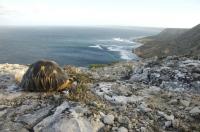
A radiated tortoise at Cap Saint Marie -- a protected area on the southernmost tip of Madagascar. Madagascar’s turtles and tortoises, which rank among the most endangered reptiles on earth, will continue to crawl steadily toward extinction unless major conservation measure are enacted, according to a recent assessment by the Wildlife Conservation Society and other groups.
The groups, which met for four days in Madagascar’s capital city Antananarivo, said there is still hope to save these ancient animals, but time is running out as their habitat continues to shrink and illegal hunting worsens. Five of the nine assessed species have been downgraded to critically endangered, with one variety – the ploughshare tortoise – now numbering only a few hundred individuals. The other critically endangered species include the radiated tortoise, flat-tailed tortoise, spider tortoise and Madagascar big-headed turtle, all of which are found nowhere else on earth.
“Madagascar’s ancient tortoises and turtles are marching toward extinction unless an all-out effort is made to protect these living national treasures,” said Dr. James Deutsch, director for the Wildlife Conservation Society’s Africa programs. “The good news is that there’s still time to save Madagascar’s tortoises and turtles from extinction, and we know how to tackle the issues.”
The workshop participants concluded that illegal trade continues to be the largest single threat for several of critically endangered species. Ploughshare, spider and flat-tailed tortoises, along with juvenile radiated tortoises, are particularly coveted by collectors and traded as pets on the international black market. Meanwhile, adult radiated tortoises are sold for food in regional markets in Tuléar and Fort-Dauphin.
In order to combat these illegal activities, the workshop participants recommended the creation of a “tortoise brigade” to monitor and control illegal trade. Confiscated tortoises could be repatriated to areas where populations had been decimated by illegal trade, and with subsequent enforcement eco-tourism opportunities could follow.
Moreso, the participants recognized that Madagascar’s traditions that once protected tortoises needed to be revitalized. Therefore, working with local people was identified as an essential component of any future conservation effort. The groups went onto say that more survey work was needed to identify unprotected tortoise populations, as well as increased captive breeding and reintroduction efforts.
The Wildlife Conservation Society, which operates field projects throughout the island nation, will open Madagascar! on June 19th – a new exhibit at its Bronx Zoo headquarters that showcases the country’s amazing biodiversity including radiated and spider tortoises. The exhibit will also be a state-of-the-art energy efficient, green building, and the first land-marked building in New York to receive a Leadership in Energy and Environmental Design (LEED) gold certification.
Source : Wildlife Conservation Society
 Print Article
Print Article Mail to a Friend
Mail to a Friend
